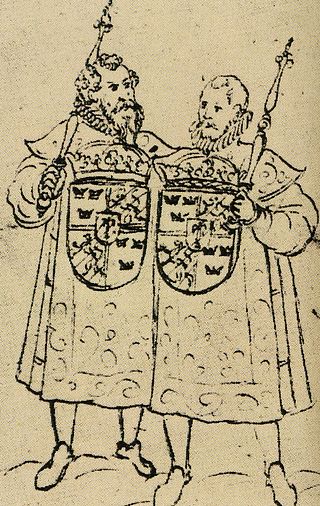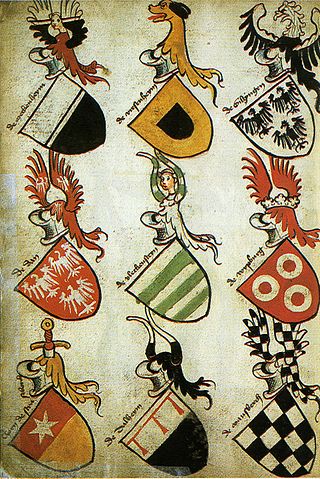A coat of arms is a heraldic visual design on an escutcheon, surcoat, or tabard. The coat of arms on an escutcheon forms the central element of the full heraldic achievement, which in its whole consists of a shield, supporters, a crest, and a motto. A coat of arms is traditionally unique to the armiger. The term "coat of arms" itself, describing in modern times just the heraldic design, originates from the description of the entire medieval chainmail "surcoat" garment used in combat or preparation for the latter.

The Right Honourable the Lord Lyon King of Arms, the head of Lyon Court, is the most junior of the Great Officers of State in Scotland and is the Scottish official with responsibility for regulating heraldry in that country, issuing new grants of arms, and serving as the judge of the Court of the Lord Lyon, the oldest heraldic court in the world that is still in daily operation.

Swedish heraldry encompasses heraldic achievements in modern and historic Sweden. Swedish heraldic style is consistent with the German-Nordic heraldic tradition, noted for its multiple helmets and crests which are treated as inseparable from the shield, its repetition of colours and charges between the shield and the crest, and its scant use of heraldic furs. Because the medieval history of the Nordic countries was so closely related, their heraldic individuality developed rather late. Swedish and Finnish heraldry have a shared history prior to the Diet of Porvoo in 1809; these, together with Danish heraldry, were heavily influenced by German heraldry. Unlike the highly stylized and macaronic language of English blazon, Swedish heraldry is described in plain language, using only Swedish terminology.

The Canadian Heraldic Authority is part of the Canadian honours system under the Canadian monarch, whose authority is exercised by the Governor General of Canada. The authority is responsible for the creation and granting of new coats of arms, flags, and badges for Canadian citizens, government agencies, municipal, civic and other corporate bodies. The authority also registers existing armorial bearings granted by other recognized heraldic authorities, approves military badges, flags, and other insignia of the Canadian Forces, and provides information on heraldic practices. It is well known for its innovative designs, many incorporating First Nations symbolism.

The Royal Heraldry Society of Canada is a Canadian organization that promotes interest in heraldry in Canada. It was founded in 1966 and granted royal patronage in 2002.

A roll of arms is a collection of coats of arms, usually consisting of rows of painted pictures of shields, each shield accompanied by the name of the person bearing the arms.
The law of heraldic arms, sometimes simply laws of heraldry governs the possession, use or display of arms, called bearing of arms. That use includes the coats of arms, coat armour or armorial bearings. Originally with the sole function of enabling knights to identify each other on the battlefield, they soon acquired wider, more decorative uses. Today they are used by countries, public and private institutions or individuals. The first laws regarding arms were written by Bartolus de Saxoferrato and the officials who administer these matters today are called pursuivants, heralds, or kings of arms. The law of arms is part of the law in countries which regulate heraldry, although not part of common law in England and in countries whose laws derive from English law. In most European countries without monarchies, much like in the United States, there are no laws against assuming arms, with the closest legal authenticity mechanism being a pictorial copyright protection.

The Heraldry Society is a British organization that is devoted to studying and promoting heraldry and related subjects. In 1947, a twenty-year-old John Brooke-Little founded the Society of Heraldic Antiquaries. This name was changed to The Heraldry Society in 1950. It was incorporated in 1956 and is now a registered educational charity, with the registered charity number 241456.
The Heraldry Society of Scotland was founded in 1977 with the aim of improving the study of heraldry.

Heraldry in Scotland, while broadly similar to that practised in England and elsewhere in western Europe, has its own distinctive features. Its heraldic executive is separate from that of the rest of the United Kingdom.

A grant of arms or a governmental issuance of arms is an instrument issued by a lawful authority, such as an officer of arms or State Herald, which confers on a person and his or her descendants the right to bear a particular coat of arms or armorial bearings. It is one of the ways in which a person may lawfully bear arms in a jurisdiction regulating heraldry, another being by birth, through inheritance.

Heraldry in the United States was first established by European settlers who brought with them the heraldic customs of their respective countries of origin. As the use of coats of arms may be seen as a custom of royalty and nobility, it had been debated whether the use of arms is reconcilable with American republican traditions. Families from English, Scottish, Irish, Welsh, German, and other European nations with a heraldic tradition have retained their familial coat of arms in the United States. Several founding fathers also employed personal arms and a great number of Americans continue to do so.

Canadian heraldry is the cultural tradition and style of coats of arms and other heraldic achievements in both modern and historic Canada. It includes national, provincial, and civic arms, noble and personal arms, ecclesiastical heraldry, heraldic displays as corporate logos, and Canadian blazonry.

English heraldry is the form of coats of arms and other heraldic bearings and insignia used in England. It lies within the so-called Gallo-British tradition. Coats of arms in England are regulated and granted to individuals by the English kings of arms of the College of Arms. An individual's arms may also be borne 'by courtesy' by members of the holder's nuclear family, subject to a system of cadency marks, to differentiate those displays from the arms of the original holder. The English heraldic style is exemplified in the arms of British royalty, and is reflected in the civic arms of cities and towns, as well as the noble arms of individuals in England. Royal orders in England, such as the Order of the Garter, also maintain notable heraldic bearings.
A heraldic authority is defined as an office or institution which has been established by a reigning monarch or a government to deal with heraldry in the country concerned. It does not include private societies or enterprises which design and/or register coats of arms. Over the centuries, many countries have established heraldic authorities, and several still flourish today.

Jessant-de-lys is a heraldic term denoting a fleur-de-lys issuing out of any object. It is most frequently seen in conjunction with a leopard's face, meaning in heraldic language the face of a lion.
For the purposes of this article, heraldry societies are defined as private associations of people who are interested in heraldry. Heraldic authorities, which have been established by reigning monarchs or governments, are dealt with in a separate article.

The Armorial Register Limited is a British publishing company focused on heraldic and genealogical topics. It was founded in 2006 with the aim of producing works related to heraldry and associated fields of study.

The following is an armorial of the thirty individuals, who have served as governor general of Canada since Confederation.

















